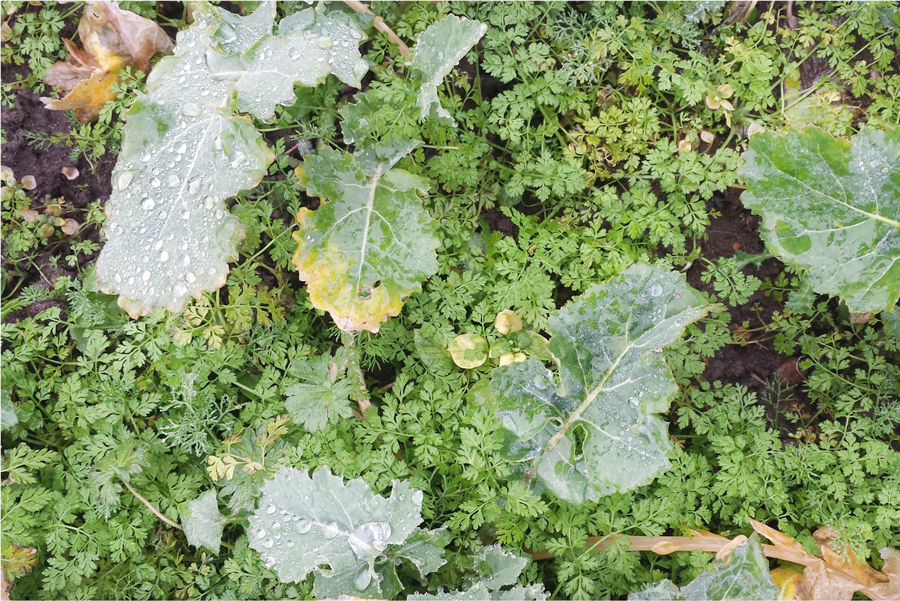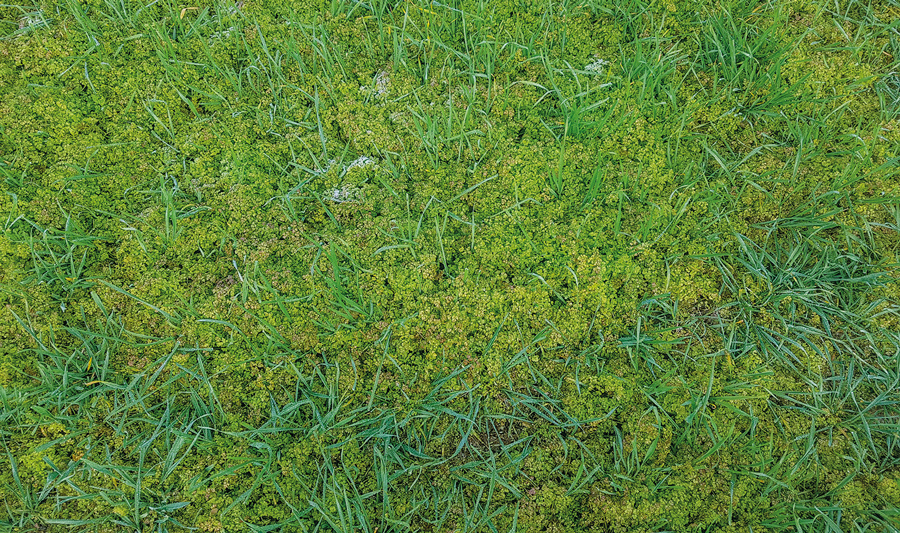Plan for early spring weed control
14th February 2020
In a normal season, spring weed control is a case of mopping up odd weeds that have come through a hefty autumn stack of residual herbicides. But 2019 wasn’t a normal year, with the autumn cereals that did get planted often receiving less residual herbicides than usual, and what was applied has been under deluge from the winter rain, making it vital that growers have an effective weed control plan for early spring.

OSR is part of the problem because none of the OSR herbicides control bur chervil, so the weed sneaks in.
In a normal season, spring weed control is a case of mopping up odd weeds that have come through a hefty autumn stack of residual herbicides. But 2019 wasn’t a normal year, with the autumn cereals that did get planted often receiving less residual herbicides than usual, and what was applied has been under deluge from the winter rain, making it vital that growers have an effective weed control plan for early spring.
Sulfonyl urea herbicides are ‘old friends’ to most agronomists and will be more important than ever this year. They’ve been the mainstay of spring herbicide programmes for more than three decades and are often used in tank mix with Starane (fluroxypyr) or phenoxy herbicides – MCPA, mecoprop and 2,4-D – the SUs revolutionised broad-leaved weed control when they were first introduced in the 1980s.
Over the past three seasons, two herbicides containing a new synthetic auxin, halauxifen-methyl (trademarked Arylex Active), from a different herbicide group (arylpicolinates) gained registration. They offer a flexible window of application for a broad spectrum of weeds but that doesn’t mean the SUs have been pensioned off, says AICC agronomist Andrew Wells of Arable Alliance in Nottinghamshire.
“Effectively, the success of DFF has shifted the weed spectrum over the past 25 years. The consequence is a new spectrum of broad-leaved weeds – with cranesbill, bur chervil and creeping hedge parsley proving to be particular problems,” he says.
He believes that it’s not just the chemistry that’s responsible for the shift in spring weed control priorities, it’s also the way they’re being used in the autumn. “Before resistant black-grass became widespread, autumn weed control used to rely mainly on isoproturon, trifluralin and DFF products or mixes and this meant a broader spectrum of weeds came through in the spring.
“These days we usually apply a stack of residuals in the autumn to tackle black-grass and so much goes on there’s only ‘mopping up’ to do in the spring. I don’t tend to see weeds such as speedwells, poppy or chickweed anymore,” he says.
Two key roles
Andrew views the sulfonyl urea herbicides as having two key roles. One is reliable and cost-effective weed control in the spring, especially where brassica weeds are present, and the second is specifically to tackle the very competitive umbelliferous weeds that are rapidly spreading in his area.
These weeds, which are readily found in verges and along hedgerows, started as a rarity in his Nottinghamshire patch about 15 years ago. When they first began to appear in crops it was so unusual that he sent weeds to the herbarium at University of Reading for identification and the first rogue umbellifer was found to be creeping hedge parsley.
Another umbelliferous weed, bur chervil, has also become increasingly problematic in Andrew’s region. “In the past five years it’s spread rapidly and can be found on all soil types in Nottinghamshire. Some farms have it, whereas other farms don’t, and it’s not known how or why it’s spreading but it’s likely due to seed movement in something – possibly in the seed, combines or in straw,” he comments.
Once they become established in a field the umbelliferous weeds spread quickly and it’s their speed of growth in the spring that can catch you out, he warns. “They emerge in the autumn and if not controlled then they will be above the canopy by April and very competitive with the crop for light, water and nutrients.”
Know the species
Agrii regional technical adviser Will Foss confirms umbellifers are an increasing problem across the country but highlights the importance of knowing which species you’re dealing with.
“I’m not sure why, but fool’s parsley, shepherd’s needle, hemlock etc are all becoming more regular. They all tend to be referred to as ‘wild carrot’ but it’s important to ID them accurately as herbicide products can vary considerably in terms of levels of control of the different species,” he says.

Symptoms of sulfonyl urea application on bur chervil are beginning to show
a week after treatment.
FMC’s Adam Espir recommends Harmony M (metsulfuron-methyl + thifensulfuron-methyl) as the preferred option for control of difficult to control umbellifers, such as wild carrot, shepherd’s needle and bur chervil. He’s been involved with the product from its early development when it was within the DuPont portfolio of sulfonyl urea herbicides and he has an encyclopaedic knowledge of the weeds it controls.
“In the work we’ve done, Harmony M provides the best levels of control, followed by Ally Max (metsulfuron-methyl + tribenuron-methyl). These perform better than Jubilee (metsulfuron-methyl), although this will still provide good levels of control in a competitive crop,” he says.
“It’s important to keep the rate of SU high and to treat early in the spring, between mid-March and mid-April, when weeds are actively growing. Wild carrot is easier to control than bur chervil, but timing is very important. Leaving these difficult umbellifers until T1 is too late,” he adds.
Andrew agrees that thifensulfuron is the key ingredient for control of bur chervil and creeping hedge parsley in cereals and says he’s finding it’s best to apply at T0 or earlier to prevent weeds becoming competitive with the crop.
“The SU label allows application from 1st February and it’s best to get on as soon as you can to control bur chervil, when there’s a bit of moisture and growth but while it’s still small. I’ve found it’s possible to use a reduced dose early under good conditions but as soon as the weed gets bigger you need to use a full dose,” he comments.
Controlling the difficult umbellifers is a little trickier in winter barley because Harmony M doesn’t have approval for use in the crop, meaning alternative sulfonyl ureas have to be used, he points out.
Adding a phenoxy herbicide to the SU can also boost bur chervil and wild carrot control. In FMC trials fluroxypyr or dicamba plus mecoprop-p have proven to be the best tank-mix partners, says Adam. For the weed spectrum he’s dealing with, Andrew prefers to use MCPA, which he finds to be one of the better remaining options where SU resistant poppy are present, as well as providing extra activity on umbellifers.
“Adding older hormone chemistry does broaden the weed spectrum but you need to be careful with tank-mixing, and in particular avoid mixing with manganese,” he adds
Finding the right sulfonyl urea
Allowing bur chervil to get away can be a costly and embarrassing problem, says Thomas Channing, who helps manage Leyfields Ltd,
a 1,100ha family business in Kneesall, Nottinghamshire.
“10 years ago we lost a substantial area of wheat on light land to bur chervil. We had a very dry April and the weed completely took over and robbed all the moisture from the soil.”
Since bur chervil first became an issue about 12 years ago, Tom and his uncle have worked with their agronomist, Andrew Wells, to find the best way to control it. Black-grass dictates a hefty autumn dose of residual products and the only real weeds left to deal with in the spring are bur chervil and cleavers.
Thomas is BASIS qualified and regularly walks the crops himself. He also does the spraying so knows exactly where he’s likely to find bur chervil in fields.
“It tends to be in patches and, once it’s in a field, a clump will emerge in the same place in following years. We went through the process of finding the right sulfonyl urea and for us it’s Harmony M. By late autumn bur chervil is visible from the sprayer and we aim to control it early in the spring, before it gets going,” he says.
Where timing has been unavoidably delayed, it isn’t necessarily a disaster if growing conditions are good, he adds. “We’ve had to spray when bur chervil was 50cm high and the Harmony M dealt with them well, with symptoms showing seven days after application and after two weeks they were no longer an issue.
“We’re slowly getting on top of the problem, but bur chervil is still creeping into fields that it wasn’t in before,” he says.
Where exactly the weed is coming from is still unknown, but Thomas suspects it may be coming in with poultry manure. “Last year we had a field which had poultry manure applied for the first time in a long while and bur chervil appeared for the first time. It was sprayed out in year one which means it hasn’t had a chance to complete its lifecycle, so it’ll be interesting to see what happens this spring.”
Difficulties managing bur chervil in the other crops within the rotation is one of the reasons it’s so difficult to get rid of, believes Thomas. The farm grows 285ha of oilseed rape, with 350ha in first winter wheat, 147ha in second wheat and 190ha in spring barley. On the lighter land 64ha of maize is grown for AD and the remainder of the farm is split between grass and fallow/margins/wild bird covers.
“OSR is part of the problem because none of the OSR herbicides control bur chervil so the weed sneaks in. We grow a lot of spring barley to help control black-grass and the crop gives us an opportunity to get rid of the weed before planting the crop because it’s an autumn germinator,” he comments.
“In the wheat we have to spend an extra £12–£14/ha to control bur chervil, but we’ve found we don’t need to do anything extra for cleaver control because we’re going in with the Harmony M when the weeds are small,” he concludes.
